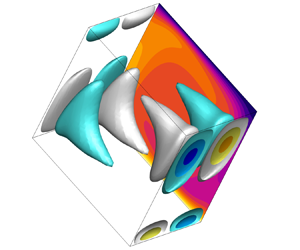No CrossRef data available.
Article contents
Three-dimensional stability of natural convection flows in inclined square enclosures
Published online by Cambridge University Press: 13 January 2025
Abstract

The three-dimensional stability of two-dimensional natural convection flows in a heated, square enclosure inclined to the horizontal is investigated numerically. First, the computational procedure is validated by comparison of base flow solutions to results reported in literature across a range of inclinations. A bi-global linear stability analysis is then conducted to investigate the stability of these two-dimensional base flows to infinitesimal three-dimensional perturbations, and the effect that buoyancy forces (defined by a buoyancy number  $R_N$) and enclosure inclination
$R_N$) and enclosure inclination  $\theta$ have on these stability characteristics. The flow is first observed to become three-dimensionally unstable at buoyancy number
$\theta$ have on these stability characteristics. The flow is first observed to become three-dimensionally unstable at buoyancy number  $R_N = 213.8$ when
$R_N = 213.8$ when  $\theta$ is
$\theta$ is  $180^\circ$; this increases to
$180^\circ$; this increases to  $R_N = 2.54 \times 10^4$ at inclination
$R_N = 2.54 \times 10^4$ at inclination  $\theta =58^\circ$. It is found that the two-dimensional base flow is more unstable to three-dimensional perturbations with the critical
$\theta =58^\circ$. It is found that the two-dimensional base flow is more unstable to three-dimensional perturbations with the critical  $R_N$ corresponding to three-dimensional instability being significantly lower than its two-dimensional counterpart across all considered inclinations except
$R_N$ corresponding to three-dimensional instability being significantly lower than its two-dimensional counterpart across all considered inclinations except  $83^\circ \leq \theta \leq 88^\circ$, where the most unstable mode is a two-dimensional oscillatory mode that develops in the boundary layers along the conducting walls. Eight different leading three-dimensional instability modes are identified, with inclinations
$83^\circ \leq \theta \leq 88^\circ$, where the most unstable mode is a two-dimensional oscillatory mode that develops in the boundary layers along the conducting walls. Eight different leading three-dimensional instability modes are identified, with inclinations  $58^\circ \leq \theta < 88^\circ$ transitioning through an oscillatory mode, and inclinations
$58^\circ \leq \theta < 88^\circ$ transitioning through an oscillatory mode, and inclinations  $88^\circ \leq \theta \leq 180^\circ$ transitioning through a stationary mode. The characteristics of the primary instability modes corresponding to inclinations
$88^\circ \leq \theta \leq 180^\circ$ transitioning through a stationary mode. The characteristics of the primary instability modes corresponding to inclinations  $88^\circ \leq \theta \leq 179^\circ$ indicate the presence of a Taylor–Görtler instability.
$88^\circ \leq \theta \leq 179^\circ$ indicate the presence of a Taylor–Görtler instability.
- Type
- JFM Papers
- Information
- Copyright
- © The Author(s), 2025. Published by Cambridge University Press



